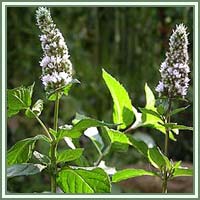PEPPERMINT
Mentha × piperita
Common name: Peppermint, Mint
Latin name: Mentha piperita
Other names: Corn Mint, Lamb Mint, Western Peppermint
Family: Lamiaceae
Habitat: Peppermint is native to Europe and Asia.
Description: Peppermint is a herbaceous perennial, a hybrid plant being result of a cross between Spearmint (Mentha spicata) and Watermint (Mentha aquatica). It has a fleshy rhizome with fibrous roots. Leaves are opposite, green, oval and toothed along the margins. It flowers from July to September, bearing small, violet flowers. Both leaves and flowers have a characteristic, aromatic fragrance.
Parts used: Leaves, flowers
Useful components: Flavonoids, phenolic acids, triterpenes, volatile oil.
Medicinal use: Peppermint is considered to have astringent, antiseptic, emetic and stimulant qualities. It has a long history of medicinal use, especially in treatment of digestive complaints. Tea made from leaves and flowers can be an excellent remedy for treatment of indigestion, cramps, flatulence, nausea, vomiting and colic. It has a soothing effect on the stomach, and can also be an appetite stimulant. Topical application of peppermint oil can reduce arthritis, rheumatism and chronic joint pain. Due to its antiseptic properties, peppermint can be helpful in the relief of toothache and in treatments of cavities. Peppermint vapors and inhalers are very helpful in cases of nasal and sinus congestions, laryngitis and bronchitis.
Safety: Some herbs could react with certain medication. Therefore it is advisable to contact your doctor/herbalist before consumption of any herb.

